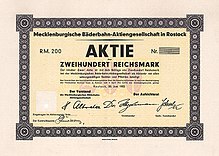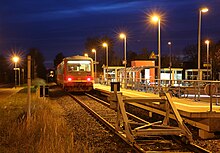Rövershagen – Graal-Müritz railway line
| Rövershagen-Graal-Müritz | |||||||||||||||||||||||||||||||||||||||||||||||||||||||||
|---|---|---|---|---|---|---|---|---|---|---|---|---|---|---|---|---|---|---|---|---|---|---|---|---|---|---|---|---|---|---|---|---|---|---|---|---|---|---|---|---|---|---|---|---|---|---|---|---|---|---|---|---|---|---|---|---|---|
| Route number (DB) : | 6943 | ||||||||||||||||||||||||||||||||||||||||||||||||||||||||
| Course book section (DB) : | 166 | ||||||||||||||||||||||||||||||||||||||||||||||||||||||||
| Route length: | 10.3 km | ||||||||||||||||||||||||||||||||||||||||||||||||||||||||
| Gauge : | 1435 mm ( standard gauge ) | ||||||||||||||||||||||||||||||||||||||||||||||||||||||||
| Route class : | CM4 | ||||||||||||||||||||||||||||||||||||||||||||||||||||||||
| Top speed: | 80 km / h | ||||||||||||||||||||||||||||||||||||||||||||||||||||||||
|
|||||||||||||||||||||||||||||||||||||||||||||||||||||||||
The Rövershagen – Graal-Müritz line is a non-electrified single-track branch line in the north of Mecklenburg-Western Pomerania . It runs from Rövershagen east of the Hanseatic city of Rostock to Graal-Müritz on the Baltic Sea . The name Mecklenburgische Bäderbahn originally stood for the operating company Mecklenburgische Bäderbahn AG and was later partly used to denote the route.
history
prehistory
At the end of the 19th century the places Graal and Müritz (at that time still two separate places) aspired to be bathing and health resorts . The connection to the larger cities was only given by poorly developed dirt roads and roads . A rail link was already required back then. The following sections of the route were discussed during the planning phase:
- Ribnitz - Müritz - Graal
- Gelbensande - Graal - Müritz
- Rostock - Nienhagen - Graal - Müritz
- Extension of the Strandbahn Warnemünde – Markgrafenheide
- Rövershagen - Graal - Müritz (direct route along the Pörstenschneise)
However, the route was initially not built due to a lack of financial resources and feared unprofitability. In addition, the cheapest connection from Rövershagen was on the Stralsund – Rostock line , which was operated by the Prussian railway . This was another reason for the Mecklenburgische Friedrich-Franz-Eisenbahn not to build a line connection here. The route via Ribnitz was rejected even more because of the strong orientation towards Prussia. It was not until 1910 that there were concrete plans to build the route again, but these were destroyed by the First World War .
Foundation, construction and operation

It was not until 1920 that there were again plans that included the construction and operation as a private branch line. The Mecklenburgische Bäderbahn AG was founded on February 28, 1925 with the aim of connecting the Baltic seaside resorts of Graal and Müritz with the main line from Stralsund to Rostock . The share capital was raised by the Hanseatic City of Rostock and numerous Rostock merchants, the neighboring communities and the Berlin tram operating company , which owned two rest homes for its staff on the Baltic coast. Another partner was the railway construction and operating company Lenz & Co. , which carried out the construction and was also entrusted with the management of the railway. Was finally realized the construction of the stretch of Rövershagen from - but with a slight turn to the west to keep open the option of extending the Warnemünde beach path to Hinrichshagen also towards Warnemünde establish a connection. The Graal-Müritz station , which was already called that before the two places were united, was built east of Graal and south of Müritz in such a way that the option to continue the route to Fischland remained. Both projects were never realized.
The 10.3-kilometer, standard-gauge line from Rövershagen to Graal-Müritz was officially opened on July 1, 1925. At first, trains only ran in summer, later also throughout the year. In the 1930s there were even through cars from Berlin in the summer . After the war, the rest homes in Graal-Müritz, which had been converted into hospitals, were taken over by the Red Army . The transports were carried out by rail and prevented the route from falling under the reparation claims . From 1949 the Deutsche Reichsbahn became the operator of the connection.
A closure was considered as early as the 1960s, but a lack of bus and truck capacities prevented this. Furthermore, the military was very interested in the route, since at that time various shooting ranges had been created in the Rostock Heath . In the 1970s, passenger traffic was limited to the summer half-year for several years, and buses operated as replacement rail services in winter .
In 1993, the Hinrichshagen and Georg Schneise stops , which were opened in the 1930s - located in the middle of the forest - were closed. Freight traffic , which had been reduced to a minimum since the mid-1970s , was ended in 1994. Because of the poor condition of the track, passenger traffic had to be stopped in 1999 and the superstructure had to be thoroughly renewed. There were different concepts for reactivation. It was planned to electrify the line and connect it to the Rostock S-Bahn network . However, this was not implemented. Passenger trains have been running again since December 12, 2004, mostly to and from Rostock Central Station . At first, renovation was questionable for a long time, only after the municipality of Graal-Müritz was able to bear a considerable part of the costs, work began. As part of the renovation, the route was shortened to 9.7 kilometers, the Graal-Müritz station was abandoned and replaced by a stop 600 meters further to the west. The new Graal-Müritz Koppelweg stop was opened for the 2006/2007 timetable change on December 10, 2006 . This has a special feature: the 100 meter long platform is made entirely of fiberglass composite .
Freight and passenger transport
Directly behind Roevershagen branches a siding from a local gas supplier, which is also currently still served. Today it is the only freight connection still served on the Rostock – Stralsund route . In the past, a sawmill at the eastern end of the village of Rövershagen was served via this siding. This plant connection was established before the construction of the railway line to Graal-Müritz. Furthermore, there were extensive track systems shortly after the Rövershagen station exit, which belonged to a granulate plant. The access tracks were removed as early as the mid-1990s and the entire area cleared with the rehabilitation of the line. Since the renovation at the latest, freight traffic to Graal-Müritz is no longer possible, as there are no loading tracks in Graal-Müritz today.
The route is used by the regional train line RB 12, the trains run almost every hour, outside the summer season on weekends only every two hours. Mostly class 642 railcars are used, and occasionally class 623 as well . Class 201 and class 346 locomotives were used in the past, followed by class 628 railcars later .
Current developments
It is considered to take up the plans from 1925 again to build a line from Graal-Müritz to Prerow and thus create a connection to the Darßbahn, which is also to be rebuilt. In view of the high number of holidaymakers and the annual growth in traffic on the Darß with only one road link, these proposals have many supporters. In 2007, the Usedomer Bäderbahn examined the feasibility of these proposals.
literature
- Lothar Schultz: Mecklenburg Spa Railway . Verlag Neddermeyer, 2007, ISBN 978-3-933254-79-5 .
- Erich Preuß: Archives of German small and private railways: Brandenburg, Mecklenburg-Western Pomerania, Berlin . transpress, Berlin 1994, ISBN 3-344-70906-2 , pp. 298-301 .
Web links
Individual evidence
- ↑ Fiegenbaum, W., Klee, W., Disused Railway Lines in Passenger Traffic in Germany 1998–1999, Stuttgart 2000, p. 17


